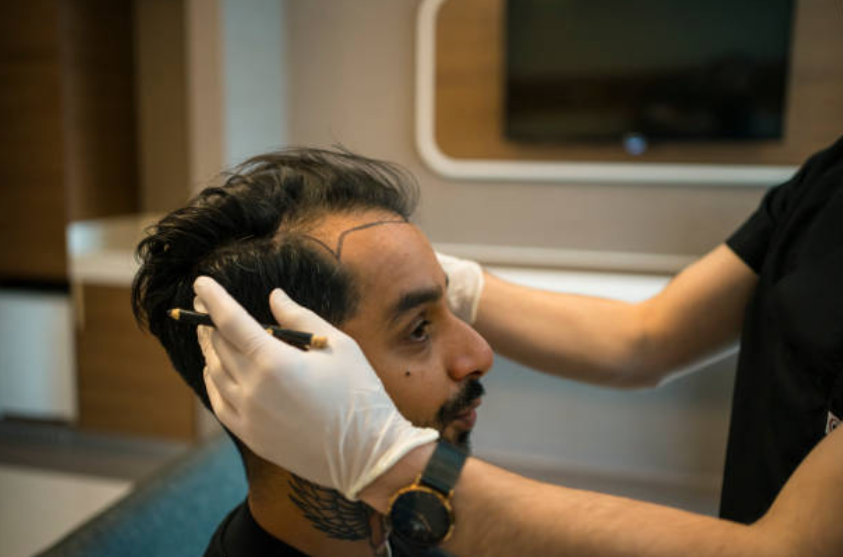Scalp micropigmentaion has become the most preferred hair treatment for Australians looking to combat hair loss. This treatment involves the injection of pigment into the scalp, creating a natural-looking “stubble” effect that can help to conceal thinning or balding areas. While scalp micropigmentation is a popular and effective choice for many people, there are certain disadvantages associated with this treatment. However, before we look at the possible disadvantages, we will look at how scalp micropigmentation works and how to prepare for it. Continue reading!
Table of Contents
How does scalp micropigmentation work?
The mechanism of action of scalp micropigmentation involves the injection of pigment into the scalp, creating a natural-looking “stubble” effect that can help to disguise thinning or balding areas. This treatment is typically performed by a trained micropigmentation specialist who will first numb the scalp and then carefully apply tiny dots of pigment in order to create the illusion of hair follicles.
This method of treating hair loss has been proven to be effective in many cases. However, there are some downsides to scalp micropigmentation that should be considered before undergoing this treatment.
How does a patient get ready for the procedure?
Before undergoing scalp micropigmentation, it is important to speak with your doctor about any medications or supplements you may be taking. You will also need to stop smoking and avoid alcohol for several days before the procedure in order to reduce the risk of scalp irritation. It is also important to have realistic expectations when it comes to scalp micropigmentation, as this treatment may not be a good choice for everyone.
Potential disadvantages of scalp micropigmentation
Here are 5 possible disadvantages of scalp micropigmentation.
1. The costs can be high
The procedure can be costly, ranging anywhere from $1,000 to over $5,000 depending on the provider. This amount is way higher for most people compared to other treatments for hair loss, such as hair transplants or medications.
2. The results are not permanent
While scalp micropigmentation can provide an effective way to cover up thinning or balding areas, this treatment is not permanent and will need to be refreshed after several years.
3. Side effects
The side effects associated with scalp micropigmentation can include scalp irritation, redness, and bruising. In some cases, more serious side effects such as hair loss may occur.
4. Results may not be what you expected
It is important to have realistic expectations about the results of scalp micropigmentation and to consult with your doctor about whether this treatment is the right choice for you.
5. May not be covered by insurance
Scalp micropigmentation is considered to be an elective cosmetic procedure and is typically not covered by insurance, which can make it difficult for some people to afford this treatment. Scalp micropigmentation can be a beneficial option for those struggling with hair loss. While there are some potential disadvantages to this treatment, such as the costs and risks associated with it, micropigmentation may be a good option for those looking for an effective, long-term solution to their hair loss concerns. If you are considering micropigmentation, it is important to talk to your doctor about your options and to weigh the pros and cons before making a decision.
How to ensure that you are getting the best results from scalp micropigmentation
To get the best treatment results from micropigmentation, consider the following:
1. Get it from the right provider
Choose the best and most highly qualified practitioner for your scalp micropigmentation procedure. This should be someone who is experienced in performing this type of treatment and has a good track record of providing satisfactory results to their patients.
2. Read reviews
Take some time to research different scalp micropigmentation providers and clinics, read reviews from past patients, and look for information on the qualifications and experience of the practitioners they work with.
3. Be realistic about your expectations
It is important to have realistic expectations when it comes to micropigmentation, as this treatment may not provide the same results for everyone. Work closely with your doctor to discuss what you can expect from this procedure and whether scalp micropigmentation is right for you.
If you are considering micropigmentation, be sure to do your research and speak with a qualified healthcare provider about your options. By taking these steps, you can help ensure that you get the best possible results from this treatment and achieve the hair restoration results that you desire.
Frequently asked questions
1. How safe is micropigmentation?
This procedure is generally considered to be safe, but it is important to choose a well-qualified practitioner and to discuss any potential risks or side effects with your doctor beforehand.
2. How long does scalp micropigmentation last?
While micropigmentation can provide an effective way to cover up thinning or balding areas, this treatment generally needs to be refreshed every few years.
3. How much does scalp micropigmentation cost?
The costs of scalp micropigmentation can vary depending on the provider you choose and other factors, such as the area being treated or your hair loss severity. Generally speaking, micropigmentation is not a covered expense by insurance providers and can be quite costly.
4. How do I find the best scalp micropigmentation provider?
There are a number of factors to consider when looking for a micropigmentation provider, such as their experience and success rates, reviews from past patients, and any certifications or accreditations they may have. To get the best results, it is important to do your research and find a reputable scalp micropigmentation provider that meets your needs.
Conclusion
If you are dealing with hair loss and looking for an effective, long-term solution, micropigmentation may be a good option for you. However, it is important to do your research and work closely with your doctor in order to ensure that you get the best possible results from this treatment. By taking these steps, you can improve your chances of achieving the hair restoration results that you desire.
This method of treating hair loss has been proven to be effective in many cases. However, there are some downsides to micropigmentation that should be considered before undergoing this treatment.











